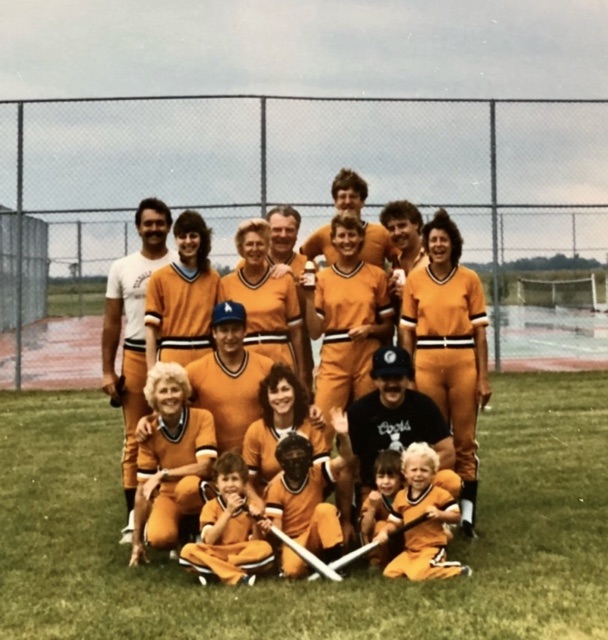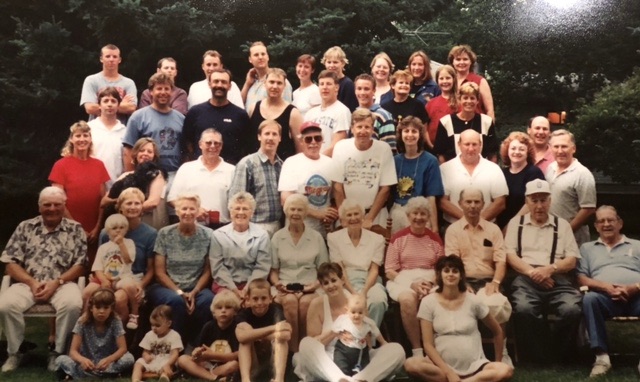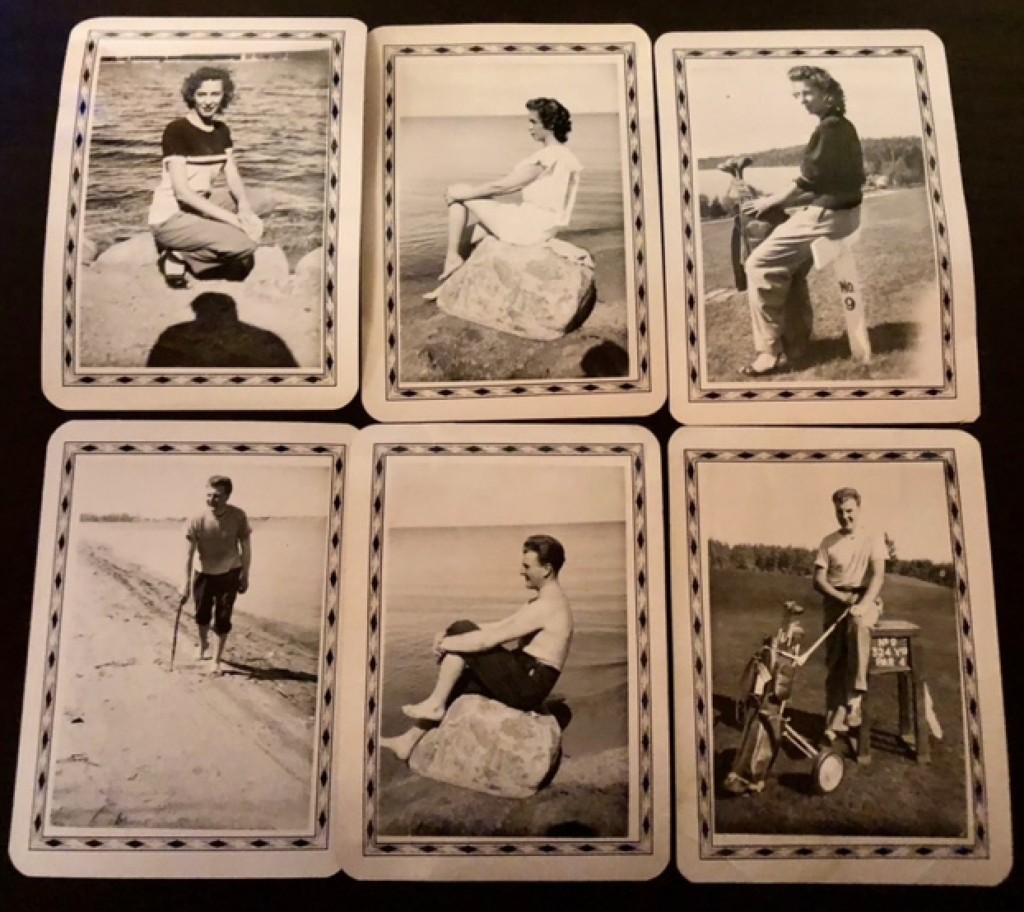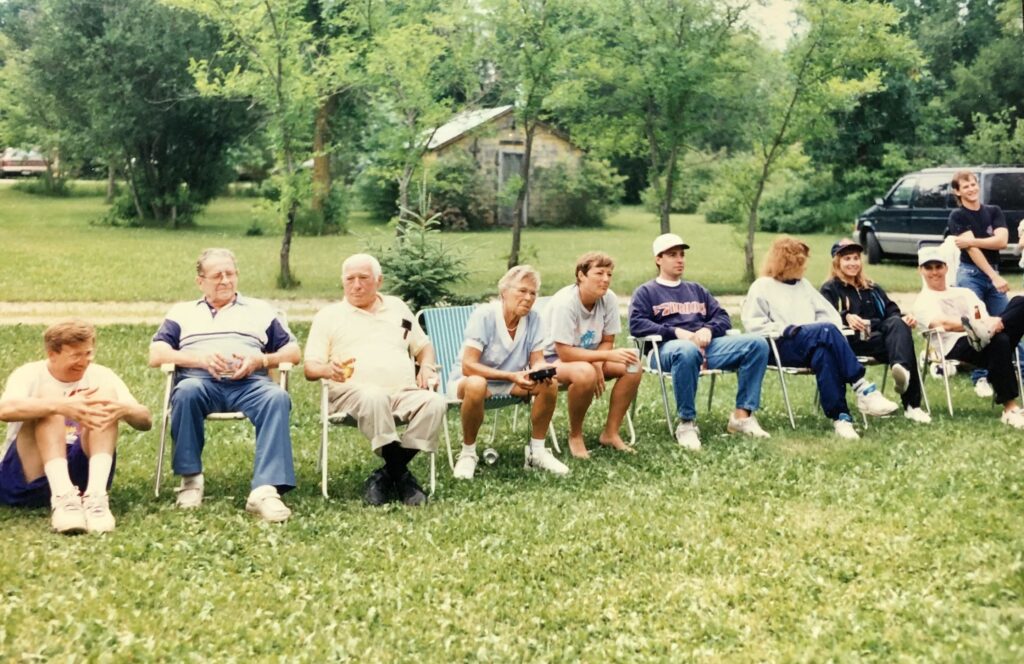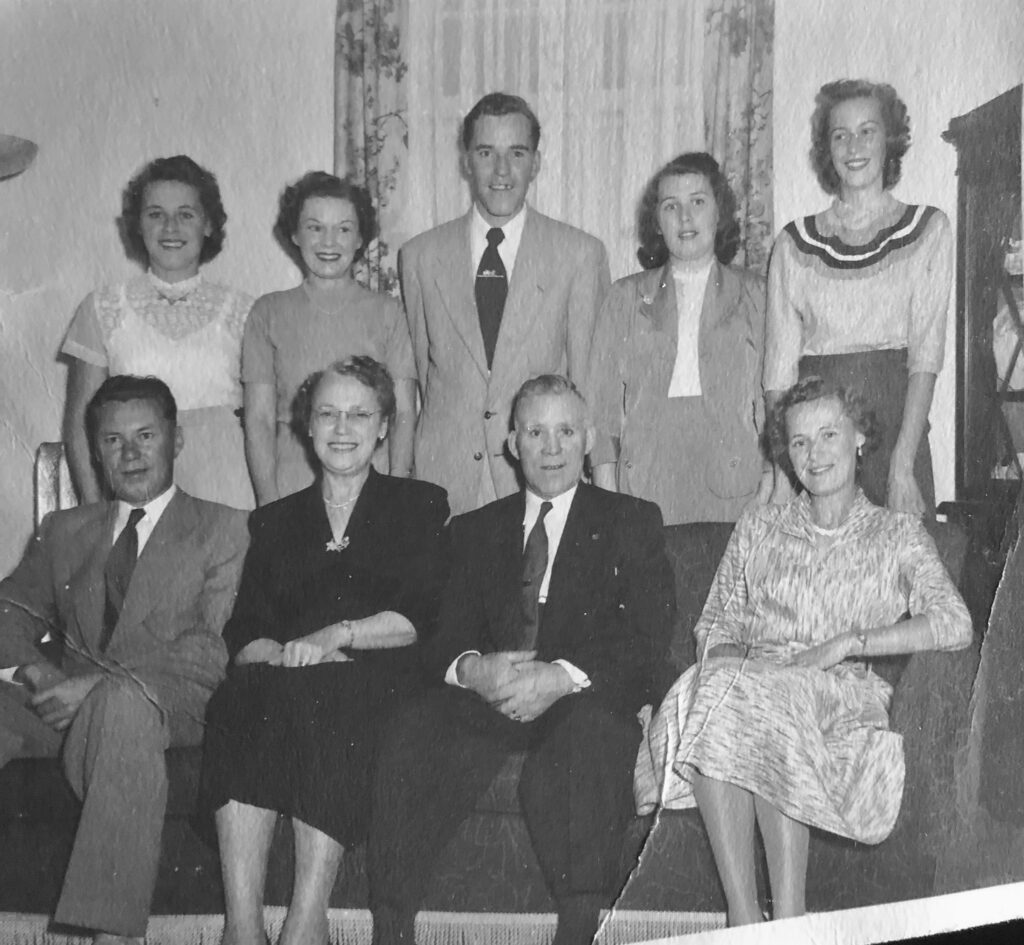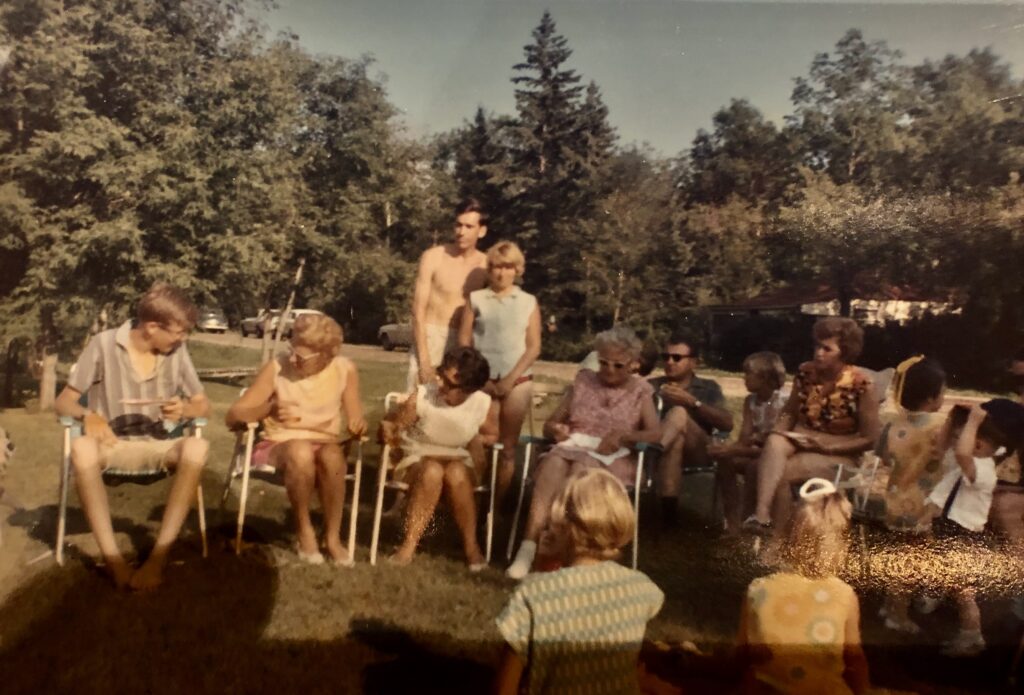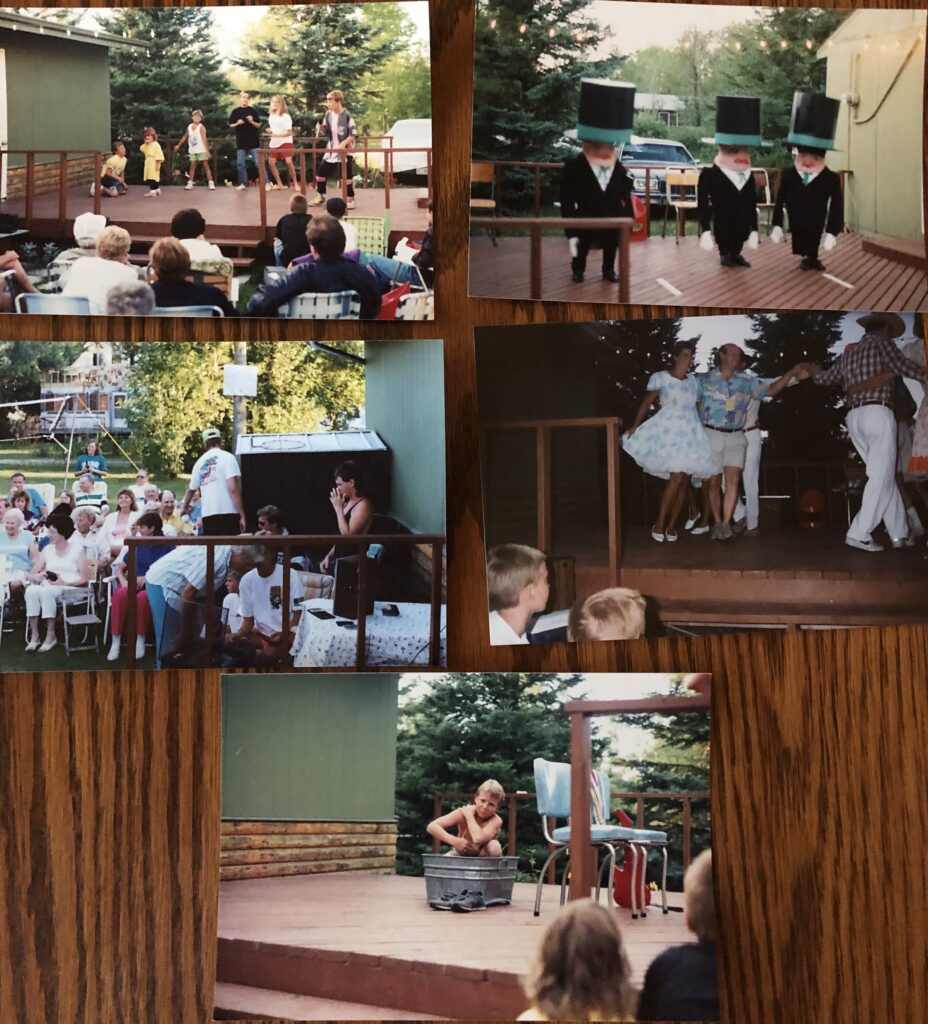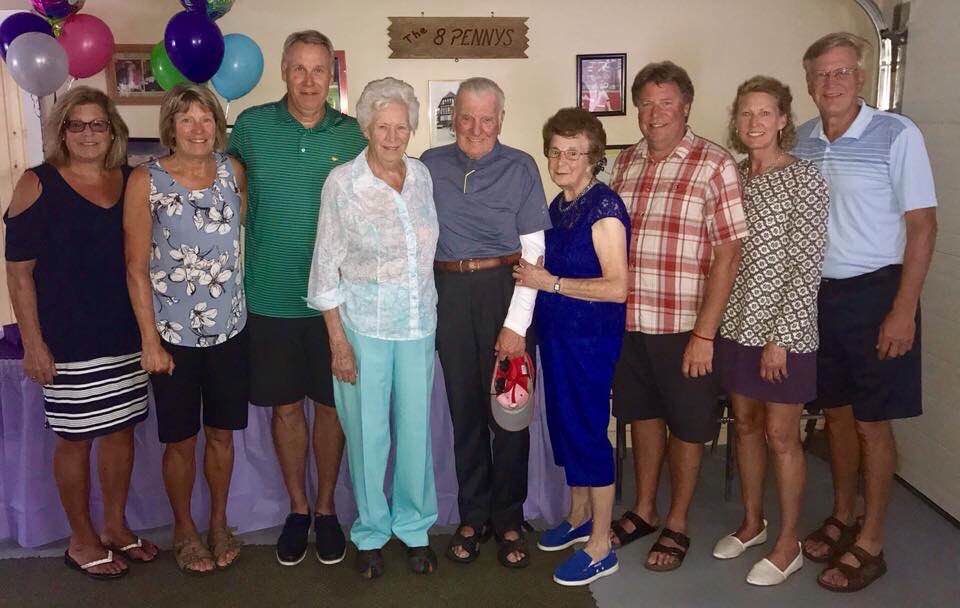Submitted by Ron Harman, July 28, 2022
(One of a series of articles about the history of South Beach and its families)
The Harman family has been connected to South Beach since the early 1940’s; but their involvement with this general area of Lake Winnipeg goes back to the 1930s.
Morris Harman and wife Beth (nee Elizabeth DeWinter) purchased five lakeside lots near Sandy Hook in the early 30’s. By today’s landmarks these lots were located a few lots North of Camp Massad and south of Jimmy Doyle’s Golf Course on PTH 519. Back then, the Salvation Army had a summer camp on the lake at the east end of PTH 519.
Two lots were cleared to build a cottage, the others remained as bush. The original cottage, lot 59, which is still there today (as a house), was about 30′ by 24′ with no interior walls. Hospital type curtains divided this single area into 4 zones. Pulled back during the day to provide one large open area; pulled closed at night to provide 3 bedrooms and a zone for the kitchen. Each “bedroom” had a Davenport that was a couch during the day and converted to a double bed at night. The massive wood stove in the kitchen area was used to heat the cottage as well as for cooking. There was an outhouse and tool shed and parking for 4 or 5 cars. No running water. Drinking water was obtained from a well about a half mile south near the Polish Pioneer cemetery. Lake water was pumped up for lawns and gardens.
Morris and Beth (grandparents to Ron and Rick Harman) had 4 surviving children; Raymond, Reginald (better known as Bud), Patricia and Gerry. The two older boys assisted with constructing the cabin. Morris was a carpenter/tinsmith by trade. He owned Kildonan Sheet Metal which he operated from his house at 330 Ottawa Avenue in East Kildonan, Winnipeg.

MORRIS HARMAN, PAT HARMAN, GLORIA STANIER
JULY 1945
The level of Lake Winnipeg varied depending on the season and the wind direction. Typically it was low during the early summer. The shoreline was course gravel, not sand, that turned into mud, complete with reeds, as you went towards the lake. Cottagers would lay 2″ x 8″ planks on the muck so you could reach the water cleanly. As the water level rose, they would reposition these boards to construct rudimentary plank piers, each section about 8 feet long and 16 inches wide, held up by posts sunk in the mud. Boats had to be brought up onto shore when not in use; hauled across some 100 feet of gumbo and gravel.
Bud Harman married Isabel Murphy in 1943, and they had two boys; Ron (1944) and Rick (1946). As a family, most of our summers were spent at South Beach, in and around the Stephen compound. We would always stop at Sandy Hook on our way there to visit with our grandparents.
When Ron was young, Grandma Harman often took him to Sandy Hook for the weekend, on the pretext of giving Isabel a break. The car ride was a fabulous experience. Granddad smoked White Owl cigars; he always had 2 or 3 in his shirt pocket. The car was a big Desoto with fabric upholstery that had absorbed years of these fumes. It was like riding in a vintage humidor. We always stopped at the Half Moon (Lockport) for ice cream. The privileges of being the eldest grandchild.
During these times, Auntie Pat, who owned a wooden Peterbough with a 10 HP Johnson would take Ron into Winnipeg Beach via water; let him drive the boat and taught him how to water ski. In 1955 they went to Winnipeg Beach to watch Kathie McIntosh complete her swim across Lake Winnipeg from Grand Beach. There was a massive flotilla of boats and a huge crowd on the beach to watch her exit the water in the early evening.
Bud Harman enlisted in the RC Navy and was stationed in Victoria where Ron was born. Following the war they returned to Winnipeg. Isabel’s older sister, Grace, had married George Stephen. Their eldest son, Allan, was born a few months after Ron. Starting in 1945, Grace and Isabel, and their boys, essentially spent all their summers at South Beach. Grace and George had their own cottage, named the Baltimore; located on Hansson Ave, a couple of lots west of Evan’s store.
Judging from the early (1945) photos taken around Dorrery Lodge, clothing was optional. Anyone familiar with the use of cloth diapers and the constant laundering involved can appreciate the benefits and time-saving aspects of simply letting the boys go ‘au naturel.

LOOKING TOWARDS THE FUTURE LOCATION OF RICK AND PAT HARMAN’S COTTAGE
At this time, Hansson and Ethel were through streets. They connected South Colonization Road to 3rd Avenue which ran along the shoreline (one cottage lot in). Benedict Street ran west from 3rd Avenue but came to a dead end in front of Dorrery Lodge; the Stephen compound.
Everything further west to South Colonization Road was basically forest. There was no Anna Avenue. There was a trail through the bush from the Stephen’s place to Hansson. This trail came out more or less in front of Evan’s store.
The lake access area at the east end of Benedict was referred to as First Beach; and the access at the east end of Ethel was called Second Beach. The shoreline between First and Second Beach was fairly muddy with rocks. You had to wade out into the lake if you wanted to walk from First to Second Beach along the shore. It was easier to use Third Avenue. However, shoreline from Second Beach all the way south to Willow Island was a beautiful expanse of sand. Second Beach was the more popular beach.

In the photo of Isabel and Grace standing with Ron and Allan (circa 1946), the view is from First Beach looking north towards Gimli. In the background you can see a wooden breakwater consisting of massive telephone-type poles drilled into the sand and bolted together. This breakwater structure remained well into the mid 1950’s. As kids, we would swim out, climb up the posts and dive into the water. We also found the remains of an old stone fireplace that was underwater just to the south of that breakwater. Obviously, previous to 1945, there must have been cottages further east on Benedict; out into what is now the lake.
In the early years, before Jean and Cec French (who owned Galway Bay located directly east of Dorrery Lodge) allowed Bud Harman to park his 16′ trailer on their lot, we would rent various places around the Stephen compound for the entire summer. One such place was the Boys Veranda attached to the east side of Dorrery Lodge.
The old Dorrery Lodge, while it was home to Mom and Pop Stephen and their seven children, had three verandas. The one on the West side was the main entrance to the Lodge, sort of a storage area, taking you directly into the kitchen. The one on the East side which had a separate outside entrance but no direct access to the main cottage was called the Boys veranda. The one on the North side which had no external access and was connected to the main cottage was called the Girls veranda.
The Boys veranda was about 8′ wide and maybe 24′ long. Sort of like a bowling lane with a door at the south end and an internal partition at the north end to form a ‘bedroom’. As was the custom back then, the partitions were about 7′ feet high, not to the ceiling; and the internal “door” was a curtain, on a rod, drawn across the opening. The entire outside wall had screened windows; but I don’t recall there being any glass. There was an ice box and a hot plate; a davenport that converted to a bed, and a table with chairs in the main section. The back room had a bed with a dresser. An old framed picture of Dogs Playing Poker was hung on the wall.
There was no running water. Drinking water was obtained from the artesian well that had been outfitted with a pump handle, located at the corner of Hansson and Third. The water was very cold and contained so much iron that the rocks around the well were orange in colour. The water tasted like blood. A daily chore was to get a pail of ‘drinking’ water. Tea made with this water not only had an interesting taste; but it left a scum-like residue in the cups.
This well water was too ‘hard’ for washing; it was impossible to produce a soapy lather. At each cottage, there were huge rain barrels, connected to the eave troughs. These collected the ‘soft’ water that was used for washing clothes, dishes and your hands. Although there were screen tops on these rain barrels, the water that was collected always looked a little sketchy; especially during fish fly season.
The toilet was the Stephen’s outhouse that was located over by their metal shed close to the chicken coop and vegetable garden. Mom Stephen collected eggs daily, and Pop Stephen would periodically decapitate a hen. There was a foot pedal style grindstone kept in the shed; used to sharpen knives and axes.
Another rental place was the Nook. This was an original version of the tiny house. Maybe it was 12′ by 12′; complete with a separate bedroom, a kitchen and a convertible couch; suitable for a family of four. Cannot recall experiencing any crowding or hardship. Obviously, as kids, we only slept, and ate breakfast and supper there. Otherwise we were outside.
On rainy days we’d be in someone’s veranda that was large enough to fit 5 or 6 kids. Jean and Cec French at Galway Bay had the best veranda; complete with a table and benches that could seat whoever showed up.
Ice was delivered, door to door, by a local vendor using a wagon. The icehouse itself was located on South Colonization Road across from Stan’s store. Periodically, one of the local fishermen would come by selling fillets of fresh pickerel.
Small wagons were a vital mode of transportation. There were used to haul water, to transport kids to the beach, to haul beach blankets and food stuffs to the lake. Everyone had a wagon.
Ron and Allan, being the same age, hung around together every summer for over a decade. We crawled through the icehouse that was located next to the fish processing plant in Gimli harbour close to where the Museum and Yacht Club are located today. Not the wisest thing to do; climbing to the top of blocks of slippery ice, covered in straw that hid the crevasses into which one could fall and never be heard from again.
We explored the Parrish and Heimbecker grain elevator; examining the weights, scales and grates. Once we climbed an inside ladder to the top of the elevator in order to look out of the small window that was up there. The wooden ladder went straight up for a very long way, through an unlit shaft. Some of the rungs were missing, so periodically you had to take an extra long step to continue. Once at the top, we convinced ourselves that we could see the water tower at Winnipeg Beach. But I doubt that we saw much past Willow Island. Climbing down was a bit scary; we only did that once.
Our Granddad Murphy was an engineer on the CPR. Sometimes he would be on the run to Riverton. On those occasions all the cousins would go to the train station to watch the big steam locomotive pull in with Granddad in the cab. Once the passengers and freight were off, we were allowed to board the coaches for the 200 yard ride to the water tank. Once filled with water, the engine would reverse to the station; and we’d get off.
A few of the older cousins were smuggled (one per trip) into the cab to ride with Granddad from Gimli to Riverton. That was a memorable experience: the distinctive smell of steam and coal and oily rags, watching the fireman open the firebox and shovelling coal into the roaring flames, viewing the many gauges and hearing the stream whistle blast whenever a crossroad occurred. The parents of which ever grandchild selected for the trip would drive to Riverton to collect the kid.

Rick, although a couple of years younger, would often tag along with Ron and Allan on these adventures. One time we walked the CPR tracks from Gimli to Winnipeg Beach with the hope of getting a day’s employment at the Boardwalk. We sat under the shallow trestle at Willow Creek as a train went over; convinced that the whole structure, which was only 3 feet above our heads, was about to collapse.
Never did get any work. The only offer was from the pony-ride guy who always set up next to the wooden rollercoaster. If we agreed to lead ponies around for 3 or 4 hours, we’d get a free ride at the end of the day. We declined.
In the late 50s, in the quiet of a summer’s evening you could hear the howling of what we thought were wolves. One day, the three of us decided we would check this out. Cutting through the bush, we snuck up on what was the back end of Gilley’s mink ranch. In addition to rows of cages containing vicious looking mink that were running hysterically around in their pens, were about eight very large husky-like dogs. These dogs were used in the winter to pull the sleds involved in ice fishing. It was the dogs that were doing the howling. The dogs looked as mean as the mink. Each dog was tied to a fairly flimsy sapling. Once they saw us, their lunges bent the trees to near breaking. We didn’t stay there very long.
The Icelandic Festival was always a big event. We’d go to the parade which involved many groups of Shriners. On average, they were a much younger group back then. Often, over that weekend, some of these Shriners, who were friends of our Aunts and Uncles would visit the Stephen compound.
But it was the races that interested us most. In the mid to late 1950s, there were cash prizes for 1st, 2nd and 3rd. Not a lot of money, but enough to acquire a stash of candy. You actually had to ‘register’ to enter a particular race. It was our mistaken belief that you had to be Icelandic to register. So we added ‘son’ to our last names.
It was customary to walk into Gimli using 3rd Ave, passing by the Arnason Cabins located on the lake at Colville. Here you could get on the stone wall walkway that took you almost to the Betel Nursing Home. The original version of this retaining wall was dramatically more narrow than what exists today. The main pier was much shorter then; with a lighthouse at the end. The Goldfield and Keenora would tie up to the main pier; while the fishing fleet boats were lashed 2 – 3 deep on the southern pier.
For a couple of years, in the late 1950s, there was a military rescue boat moored between the fishing boats on the southern pier. Only rarely did we actually see any crew on this boat. A few times we did get to speak with them; but they were pretty tight lipped. We did learn that they were there in case any T33 training planes from the Gimli airbase had to ditch into the lake. Maybe twice we saw that rescue ship race out of the harbour. But we never heard any news reports concerning aircraft accidents.
The gear on the rescue boat was quite unique; stretchers made of mesh; long handled gaffs; various floatation devices. A crew member did tell us that some pilots, particularly those from the Middle East, when flying in clouds or without a visible horizon, sometimes experience a condition such that they believe that they are flying upside down, when really they are not. So when they execute the manoeuvre of pulling up; they are actually going down and crashing into the lake.
The sand bars at Second Beach were spectacular. There were always at least two; one about 20′ off shore and another maybe 60′ off shore. You could wade to the first one. But you’d have to swim to the second one. Once you reached it, you would be standing in water often below your waist. It was always a strange sight to see someone so far out walking through the water.
The exact location and depth of the sandbars constantly changed, probably due to changes in the wind direction. Then there was the mystical third sand bar. It would be at least 100′ or more out there; if it was there at all. Only the really good swimmers would search for this elusive sandbar.
Often we would walk to Willow Island along the expansive sandy beach, which at times was over 100 feet wide. Eventually you’d reach the shallow channel that separated the beach from the island. The depth was usually less than 5 feet. So even if you weren’t in swim gear, you could strip off your clothes and hold them in a bundle over your head as you went across; commando style.
The lake side of the island was more rugged than the sandy beach. It was covered with bushes and rocks making the walk more difficult. About a mile along, there was the main channel that connected the lake to the marshy western area. This channel was very wide, very deep and had a significant current. There was no way to cross this.
When the lake water was out, you could access Second Beach with a car and drive for miles towards Willow Island. In the late 1950s older teenagers, or cadets from the Gimli airbase would take their cars down the beach to party. Later in the afternoon they’d drive back through a beach crowded with kids and supervising adults. These incidents never turned out well.
There were occasions when the beachgoers would dig fairly deep trenches across the beach, bury logs that protruded about eighteen inches out of the sand and move substantial rocks onto the beach. The returning party goers would run into this obstacle course. There were reports of some cars losing their oilpans.
Our Auntie Jean French was particularly upset with this situation. The safety of children was at stake. Somehow the Winnipeg Free Press (maybe the Tribune) heard about this, interviewed Jean and wrote an article. The headlines were something like ‘Little Peyton Place at South Beach Gimli‘. The Peyton Place reference was to a then current movie that was based on a rather (for its time) racy pocket novel. The story made it into other media outlets. Needless to say, it caused quite a stir in the otherwise sleepy ambiance of South Beach.
Sometime in the early to mid 1960’s, George Stephen, Gordon Harley and Bud Harman purchased an acre of land immediately south of the Stephen compound: Dorrery Lodge. They divided it into four quarter acre lots, which sat as idle bush for a number of years. Between 1975 and 1978, Allan and Douglas Stephen built a new cottage for their parents to replace their existing cottage: the Baltimore. Bud Harman, having cleared his quarter acre (at the southwest corner of Benedict and Anna) purchased the old cottage and had it moved to the site.


Bud and Isabel Harman, for the first time in over 20 years, now had their own cottage. This cottage was enlarged with an addition that included an indoor bathroom, another bedroom, living room and outdoor deck. This relocated and now expanded cottage was not given a real name. However, periodically, Bud would hang out a beautifully carved sign (prepared by his grandson Trevor Harman) that simply said Bugger Off.

This is the end of PART ONE; PART TWO has yet to be written.










